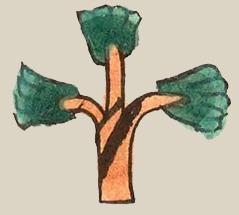cuahuitl (Mdz32r)
This glyphic element for cuahuitl has been carved from the compound sign for the place name, Chichiccuauhtla. It is a classic representation of a tree, with a leader and two branches, all with two-toned green foliage, terracotta-colored bark, and two black stripes across the trunk, one thin and one thick.
Stephanie Wood
The black stripes (tlilcuahuitl) are phonetic indicators that this sign is a tree (cuahuitl), something I discovered independently, but which has also been pointed out by Brígida von Mentz ("De árboles, raíces, y locativos en la iconografía del México antiguo," Tlalocan 15, 2008, 216–219).
Stephanie Wood
Stephanie Wood
c. 1541, but by 1553 at the latest
Stephanie Wood
trees, árboles

cuahui(tl), tree(s), https://nahuatl.wired-humanities.org/content/cuahuitl-1
tlilcuahui(tl), black stripe(s), https://nahuatl.wired-humanities.org/content/tlilcuahuitl
Codex Mendoza, folio 32 recto, https://digital.bodleian.ox.ac.uk/objects/2fea788e-2aa2-4f08-b6d9-648c00..., image 74 of 188.
The Bodleian Libraries, University of Oxford, hold the original manuscript, the MS. Arch. Selden. A. 1. This image is published here under the UK Creative Commons, “Attribution-NonCommercial-ShareAlike 3.0 License” (CC-BY-NC-SA 3.0).



